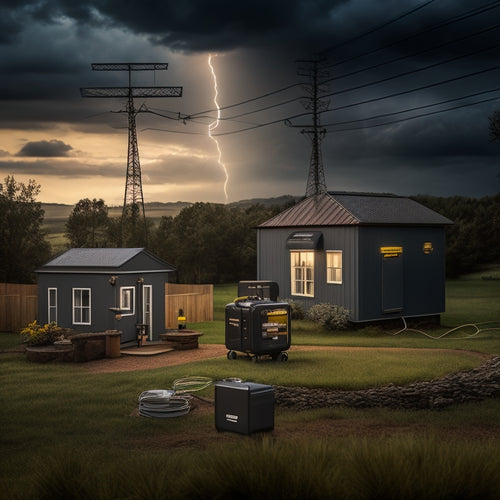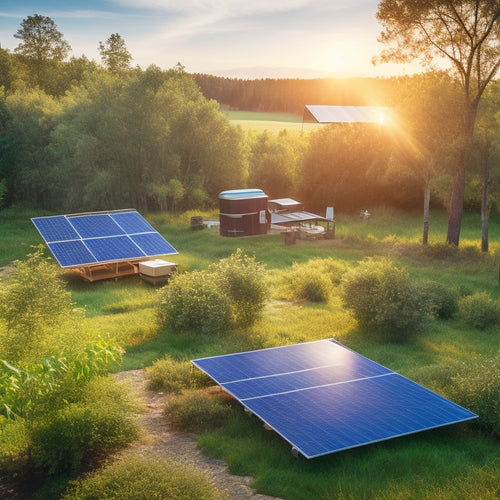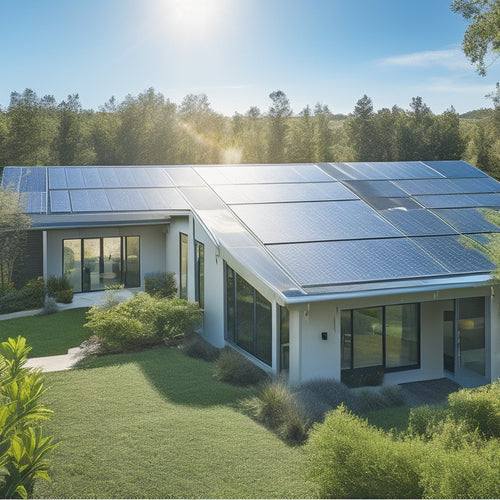
Off Grid House Solar System
Share
You can power your off-grid house entirely on solar energy, eliminating your reliance on the grid and saving up to 50% or more on your monthly electricity bills. By integrating a well-designed solar panel system with an energy storage system, you can optimize your energy consumption and production, achieving zero energy dependency. To maximize your savings, it's vital to assess your energy demands, optimize your solar panel's orientation and tilt, and select high-efficiency solar panels. As you delve into the world of off-grid living, you'll realize the importance of energy storage systems, maximum power point tracking, and efficient energy harvesting - and that's just the beginning of your expedition to energy independence.
The Essentials
- Achieve zero energy dependency by integrating Energy Storage Systems (ESS) to store excess solar energy and power homes during low solar irradiance or at night.
- Dependable energy storage systems, like Lithium-ion batteries, reduce energy expenses and ensure uninterrupted power during outages or low sunlight.
- Renewable power generation through solar technologies captures energy sustainably, contributing to a cleaner environment and reducing reliance on traditional energy sources.
- Efficient energy harvesting and optimized power output are crucial, using techniques like Maximum Power Point Tracking (MPPT) and high-efficiency solar panels.
- Accurate energy demand assessment and daily power requirements calculation are essential for off-grid solar system design and sizing to ensure sustainability.
Zero Energy Dependency
You'll achieve zero energy dependency by integrating Energy Storage Systems (ESS) that efficiently store excess energy generated by your off-grid house solar system.
This allows homeowners to maximize their solar panel investment and reduce their reliance on the grid, ultimately giving them greater control over their energy costs and a more sustainable living experience Renewable Energy.
This stored energy is then used to power your home during periods of low solar irradiance or at night.
Energy Storage Systems
Freedom from the grid's constraints begins with a dependable energy storage system, the unsung hero of zero energy dependency. You're not just storing excess energy, you're securing your independence.
As you design your off-grid system, you'll need to evaluate the best battery technologies for your needs, such as Lithium-ion batteries, which offer reduced energy expenses and uninterrupted power supply home renewable energy systems.
Additionally, a home solar power battery allows you to capture and store excess energy generated by your solar panels during the day, enabling you to power your home at night or during power outages without incurring additional costs.
Lithium-ion, lead-acid, or saltwater batteries - each has its pros and cons. Your solar inverters will work in tandem with your batteries, converting DC power to AC for your home.
Energy efficiency is key, so verify your system integration is seamless and your load management is optimized. With a well-designed energy storage system, you'll enjoy grid independence and reduced reliance on renewable incentives.
But don't forget to monitor your energy usage and battery lifespan to confirm your system remains efficient. By choosing the right energy storage solution, you'll be free to live life on your own terms, without the grid's constraints holding you back.
Renewable Power Generation
As your off-grid house solar system relies on a dependable energy storage system, it's equally important to focus on renewable power generation, the heart of achieving zero energy dependency.
This is where solar technologies come into play, offering a sustainable way to capture energy from the sun. By investing in renewable power generation, you're not only reducing your reliance on the grid but also contributing to a cleaner environment.
With off-grid solar kits solving three major problems, you can enjoy the peace of mind that comes with knowing you have control over your own power needs.
Renewable investments in solar technologies can provide a significant return, especially when paired with energy-efficient systems.
Lower Monthly Electricity Bills
You'll greatly reduce your energy consumption by utilizing the power of the sun, which in turn will lower your monthly electricity bills.
By adopting off-grid energy solutions, you'll not only reduce your reliance on traditional energy sources but also contribute to a more sustainable future.
By installing an off-grid house solar system, you'll cut down on expenses associated with traditional energy sources.
This means you'll have more control over your energy costs, and you'll be able to allocate your resources more efficiently.
Reduce Energy Consumption
Three primary factors contribute to the success of an off-grid house solar system: a well-designed solar array, a reliable energy storage system, and efficient energy consumption. You can achieve the latter by reducing your energy consumption, which is essential for living off the grid. This means adopting an energy-conscious lifestyle and leveraging technology to your advantage.
| Appliance | Energy Efficiency | Smart Home Integration |
|---|---|---|
| LED Lighting | 90% more efficient than incandescent bulbs | Compatible with smart home systems for scheduling and automation |
| Energy Star Refrigerator | 15% more efficient than traditional refrigerators | Can be monitored and controlled remotely |
| Power Strips | Eliminates standby power consumption | Can be integrated with smart home systems for automation |
Cut Down Expenses
By reducing your energy consumption, you've taken the first step towards minimizing your reliance on the grid.
Now, it's time to cut down expenses and lower your monthly electricity bills. With a well-designed solar system, you can greatly reduce your energy costs.
To maximize your savings, you'll need to evaluate your budget planning and investigate available solar incentives.
These can include federal and state tax credits, rebates, and grants that can help offset the initial cost of your solar system.
Maximum Power Point Tracking
You'll want to guarantee your off-grid house solar system is equipped with maximum power point tracking (MPPT) to facilitate efficient energy harvesting.
This is especially important when considering off-grid systems that require reliable power supply.
MPPT optimizes power output by continuously monitoring and adjusting the voltage and current of your solar panels to match the ideal operating conditions.
Efficient Energy Harvesting
Throughout the varying levels of solar irradiance, your off-grid house solar system relies on efficient energy harvesting to maximize its power output. This is vital because solar panels don't always operate at their maximum capacity.
To address this, you'll need to implement advanced energy harvesting techniques that enhance your system's performance.
One key factor affecting solar panel efficiency is the maximum power point tracking (MPPT) mechanism. MPPT guarantees that your solar panels operate at the ideal voltage and current to generate the maximum power output. By continuously monitoring and adjusting the operating conditions, MPPT helps you extract the most energy from the sun.
To further enhance energy harvesting, consider using high-efficiency solar panels with low temperature coefficients. These panels are designed to maintain their performance even in high-temperature conditions, guaranteeing you get the most out of your system.
Optimized Power Output
Enhanced Power Output (Maximum Power Point Tracking)
The solar panel's power output curve is non-linear, meaning its maximum power point varies depending on temperature, irradiance, and other environmental factors. To guarantee you're getting the most out of your solar panel system, you need a maximum power point tracking (MPPT) controller. This device continuously monitors the panel's output and adjusts the operating voltage to extract the maximum available power.
By doing so, it compensates for changes in temperature, irradiance, and other environmental factors that affect the panel's performance. You can further enhance your system's power output by considering the solar panel orientation and conducting a shading analysis.
By positioning your panels at the ideal angle and minimizing shading, you can increase energy production. Additionally, MPPT controllers can handle multiple strings of panels with different orientations, allowing you to maximize energy harvesting even in complex installations.
With an MPPT controller and proper system design, you can feel confident that your off-grid house solar system is producing the maximum power possible, giving you the freedom to live off the grid.
Assess Your Energy Demands
You need to understand your energy usage patterns to determine how much power your off-grid house solar system must provide.
When opting for renewable energy systems, it's crucial to take into account your energy storage batteries and solar charge controllers to guarantee a seamless off-grid power experience sustainable energy systems.
To do this, you'll want to calculate your daily power requirements, including the total watt-hours required by your appliances, lighting, and other devices.
Energy Usage Patterns
Energy usage patterns, a critical aspect of off-grid house solar system design, dictate the size and complexity of your solar array. Your energy usage patterns directly impact the number of solar panels you'll need, the type of charge controller and inverter required, and the size of your battery bank.
To guarantee energy efficiency, you need to understand your usage behavior. You should identify your energy-intensive appliances, such as refrigerators, air conditioners, and electric water heaters, which consume a significant portion of your energy.
Additionally, consider your lighting needs, entertainment systems, and computer usage. Evaluating your energy demands will help you determine the required solar array size to meet your energy needs.
Daily Power Requirements
Your daily power requirements serve as the foundation for determining the size of your off-grid house solar system. Accurately evaluating your energy demands is essential for a sustainable living setup that meets your needs. To achieve energy efficiency, you need to calculate your daily power requirements in watt-hours (Wh).
| Appliance | Wattage (W) | Usage Hours/Day |
|---|---|---|
| Refrigerator | 150 | 8 |
| Laptop | 65 | 4 |
| LED Lights | 10 | 6 |
| Water Pump | 500 | 2 |
| TV | 100 | 4 |
Higher Energy Conversion Rate
You can maximize your solar panel output by optimizing the system's configuration and selecting high-efficiency panels.
Higher-efficiency panels convert more sunlight into electricity, resulting in a higher energy conversion rate.
Maximize Solar Panel Output
Optimizing solar panel orientation and tilt guarantees maximum energy harvesting, as even slight misalignments can greatly reduce power output. You must verify your solar panels are positioned to capture the most sunlight possible. A south-facing orientation is ideal, but you can still achieve high energy conversion rates with east- or west-facing panels. The key is to avoid shading from trees, buildings, or other obstacles.
Conduct a shading analysis to identify potential issues. This involves evaluating the solar path throughout the day and year to determine the best panel placement. You can use online tools or consult with a solar expert to perform the analysis. By doing so, you'll be able to optimize your solar panel orientation and tilt, resulting in higher energy conversion rates.
Additionally, consider using a solar tracking system, which adjusts the panel angle to follow the sun's movement. This can increase energy output by up to 45%.
Frequently Asked Questions
Can I Use Solar Panels With My Existing Electrical System?
You can integrate solar panels with your existing electrical system, but first, verify compatibility by checking your system's voltage, ampere, and wattage ratings, then consult with an electrician to determine the best connection method for a seamless changeover.
How Long Does It Take to Install an Off-Grid Solar System?
You're likely thinking, "won't installation be a nightmare?" But, surprisingly, the installation timeline is relatively swift. The complexity of the system determines the duration, typically ranging from a few days to several weeks, depending on your specific setup.
Are Off-Grid Solar Systems Suitable for Small Homes or Apartments?
You're wondering if small homes or apartments can benefit from off-grid solar systems, and the answer is yes! They're perfect for achieving sustainability benefits and energy independence, allowing you to break free from the grid and enjoy clean, self-sufficient power.
Can I Add More Solar Panels to My Existing Off-Grid System?
You're wondering if you can add more solar panels to your existing setup - the answer is yes, you can, as long as you verify solar panel compatibility and investigate system expansion options that align with your original configuration.
Do I Need to Purchase a Special Type of Solar Panel for Off-Grid Use?
When selecting solar panels, you'll want to confirm they're compatible with off-grid systems, looking for panels with high voltage and current ratings, and checking for certifications like UL 1741, which guarantees off-grid compatibility, giving you the freedom to choose the right solar panel type for your needs.
Final Thoughts
In going off-grid with a solar system, you'll be utilizing the power of the sun to fuel your home, slashing your reliance on the grid. This means zero energy dependency and considerably lower monthly electricity bills. With maximum power point tracking, your system will optimize energy production. By evaluating your energy demands, you'll guarantee a seamless changeover. Plus, modern solar panels boast a higher energy conversion rate, making the most of available sunlight. In fact, did you know that a typical residential solar panel system can save up to $500 annually on electricity costs?
Related Posts
-

Key Components of a Reliable Emergency Power Supply System
A reliable emergency power supply system requires several key components. You need proven performance metrics to guar...
-

Top Off Grid Solar Batteries for Renewable Energy
When seeking top off-grid solar batteries for renewable energy, consider options with advanced battery chemistry, suc...
-

Installing Metal Solar Roofs for Maximum Energy Efficiency
Installing metal solar roofs can drastically enhance your home's energy efficiency and durability. These roofs withst...


